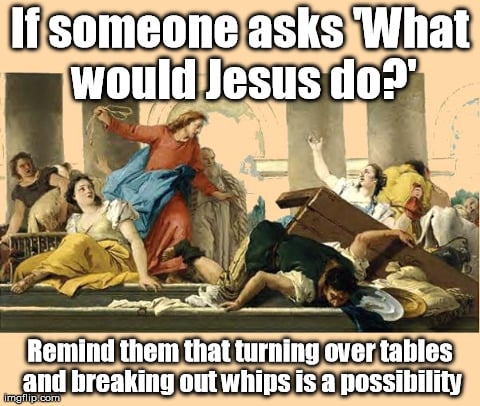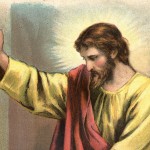In a recent exchange on a Facebook feed about possible responses to the ISIS beheadings of Coptic Christians, it was suggested to me that, as a result of a deficiency in a particular part of my anatomy, I didn’t have the courage to do what really needed to be done. My attention was then brought to the fact that Jesus was no wimp. No sir, he knew how to take care of business. The typical proof text was then trotted out, the Gospel for the upcoming Third Sunday of Lent, John 2:14-16, which reads:
He found in the temple area those who sold oxen, sheep, and doves, as well as the moneychangers seated there. He made a whip out of cords and drove them all out of the temple area, with the sheep and oxen, and spilled the coins of the moneychangers and overturned their tables, and to those who sold doves he said, “Take these out of here, and stop making my Father’s house a marketplace.”
I was told – as I have been told so many times before, in discussions about everything from the invasion of Iraq, military stockpiling, keeping guns in the house, getting in fistfights – that this text proves that Jesus was not against the use of violence. He was willing to strike at people with a whip. He could roll up his sleeves and take a swing. As the picture here suggests, that is what Jesus would do.
The use of this text to justify violence (burning heretics, going on crusades, engaging in “just warfare”) has a long history. Since the accounts of this event in the other Gospels (Matthew 21:12; Mark 11:15; Luke 19:45) don’t include a whip at all, people tend to use this John passage as their proof text. In fact, in Mark (as in John), the word “drove” is the same word used for the Spirit “driving” Jesus into the desert in Mark 1:12 and Jesus “driving” demons out of people throughout the Gospel. It is a strong word, but the coercive power that it implies relies on the authority of the voice of Jesus, a voice that is moved by the Spirit of God, rather than by any kind of physical strength.
So what actually happens in the scene? Jesus, making a whip out of some ropes he found lying around, drove out the sheep and oxen (presumably their owners followed them out). Then he overturned the tables of the moneychangers. Finally, he tells the people selling doves to get out. He neither swings at the doves in their cages, nor does he whip any people. He uses a rope to drive out the sheep and oxen, like any shepherd or cattle herder would do.
And that is it.
Does Jesus get fired up? Yes. Does he perform a calculated prophetic action evocative of the temple condemnation in Jeremiah 7:1-15? Yes. Does he lose control and get so angry that he starts striking people with a whip? No, he never does that (though just about every picture that comes up in Google Images under this scripture passage shows Jesus swinging at people. Go ahead, check). He never hits people, never mind engage in action that somehow justifies as a prooftext for military action.
Nothing in this passage serves as justification for doing physical violence to other human beings, much less as a “just war” proof text. Jesus was no sissy, but not because he went around whipping merchants. If we want an example of his “manliness,” we need look no further than Sunday’s second reading from 1 Corinthians 1:22-25: “We proclaim Christ crucified… [for] the weakness of God is stronger than human strength.” Unfortunately (for some), such passages don’t justify the pummeling of one’s neighbor. We may just have to deal with the fact that it’s us, and not Jesus, who seem to want and need that justification.
***
However, since I have heard people make this claim so many times, it may be helpful to provide a detailed explanation, to help drive out any doubt about what Jesus is doing in this passage.
I recently read an excellent article in the Biblical Interpretation Journal by Andy Alexis-Baker on this passage in John, and I would like to highlight and summarize some of his major points (I take the Augustine and Cosmas quotes from this article, as well as much of the grammatical commentary).
Up until Augustine, no one interpreted John 2:15 to condone violence or even to imply that Jesus had struck any human beings. In the first three hundred years in the life of the Church, Origen was the only person to comment on this passage, and he gave it a purely spiritual rather than literal reading. His reason?
Let us consider whether [the fact that] the Son of God takes cords, [makes] a whip for himself and expelled them from the temple does not reveal one who is self-willed, reckless and undisciplined.
And Cosmas Indicopleustes writing ca. 550 AD argued:
Answer: What is alleged is false, for he did not in any way strike a human being, but he adopted an admirable and becoming and appropriate course, for he struck the brute beasts only, as it is written: “And having made a whip of cords he expelled all from the temple, both the sheep and the cattle.” But the rational beings he neither struck nor pushed away, but chastised with speech, as it is written: “And to those who sold doves he said, ‘Take these things hence, and do not make my Father’s house a marketplace.’”
St. Augustine was the first to use this passage to justify force, including the just use of force in war. Was Augustine justified in doing so? A quick look at the grammar of the passage shows that he was not.
For those who want to see the Greek, the passage in John 2:15 reads:
Καὶ ποιήσας φραγέλλιον ἐκ σχοινίων πάντας ἐξέβαλεν ἐκ τοῦ ἱεροῦ τά τε πρόβατα καὶ τοὺς βόας, καὶ τῶν κολλυβιστῶν ἐξέχεεν τὸ κέρμα καὶ τὰς τραπέζας ανέτρεψεν.
My own literal translation would be:
“And making a whip from rope, he drove them all from the temple, both the sheep and the oxen, and he poured out the coins of the moneychangers, and he overturned the tables.”
Then, in verse 16, he tells those selling doves to get out of there too.
Now the question is: What does the “pantas,” the “them all,” refer to? Is Jesus whipping people and animals, or just animals? Without getting too technical, the answer is: He’s referring to the sheep and oxen.
The first obvious reason for this is that he clearly doesn’t drive out the doves and their owners since he tells them to leave in vs. 16. So the “them all” doesn’t include everyone mentioned in vs. 14.
Next, the use of a “te…kai” construction is important. Te…kai, used 90 times in the New Testament, always means “both…and.” It is also often used, when it follows a plural noun, as a partitive appositive, meaning it is used like a further adjective to break down the meaning of its referent. In this case, “both the sheep and the oxen” is in apposition to “all,” placed there by John to clarify who exactly he means by “them all.”
Finally, John uses the masculine plural adjective pantas to refer to the sheep and oxen because he had no other option. If he had used the neuter panta, he would be referring only to the sheep, if the feminine, only the doves (who are not asked to leave till vs. 16). So his only option is a masculine plural, which can cover both the oxen and the sheep. While sheep is a neuter noun, it can be covered by a masculine pronoun since all of the sheep for sacrifice were required to be male.













